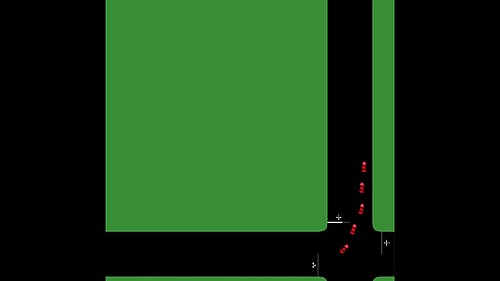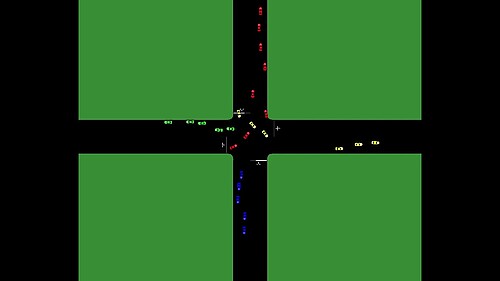Video Playlist 19: Joint optimal control of CAV platoons crossing lane-free signal-free intersections
The videos included in this playlist are a part of the results discussed in the paper titled "Joint optimal control of CAV platoons crossing lane-free signal-free intersections". This paper presents a joint optimal control method for both individual CAVs and CAV platoons crossing signal-free and lane-free intersections. The control inputs of all vehicles, both individual ones and platoon members, are optimized jointly over a time-horizon by solving a single optimal control problem (OCP). The cost function includes proper terms to ensure smooth and collision-free motion, while also considering fuel consumption and desired-speed tracking, when possible. In particular, a platooning term is considered to regulate the inter-vehicle distance, which is highly flexible and allows a crossing platoon to split when it faces collision risk. Appropriate constraints are designed to respect the intersection boundaries and ensure smooth vehicle movements towards their respective destinations.
Operating a single crossing platoon
In this video, the results of applying the proposed method to a single platoon, comprising 5 left-turning vehicles, whose initial states deviate from the ideal platoon condition, are shown. The video shows that vehicles smoothly drive and cross the intersection, elegantly turning left towards their destination. In more detail, vehicles also strive to regulate the longitudinal and lateral distances. For instance, the initial longitudinal distance between the first and second vehicles is higher than the desired value, resulting in deceleration of the first vehicle and acceleration of the second one. Moreover, except for the stronger steering needed for left turning, some small steering angles are also generated to attenuate differences in the vehicle lateral distances.

Controlling multiple crossing CAV platoons
This video illustrates the results of applying the suggested approach to a total of 24 vehicles forming 6 platoons with different numbers of vehicles, some of which have antagonistic ODs. As seen, vehicles with different ODs drive towards their respective destinations simultaneously without collisions, featuring smooth and fast motion and remaining within the intersection boundaries. Also, if necessary, platoons elegantly and spontaneously split into two or even more parts, to avoid collisions and, after overcoming the collision risk, rejoin to reach the desired formation. The physical limits of control signals, i.e. acceleration and steering angle, are satisfied. Geometrical intersection data and vehicle data (dimensions, desired speeds, physical limits, etc.) are provided in the paper.


